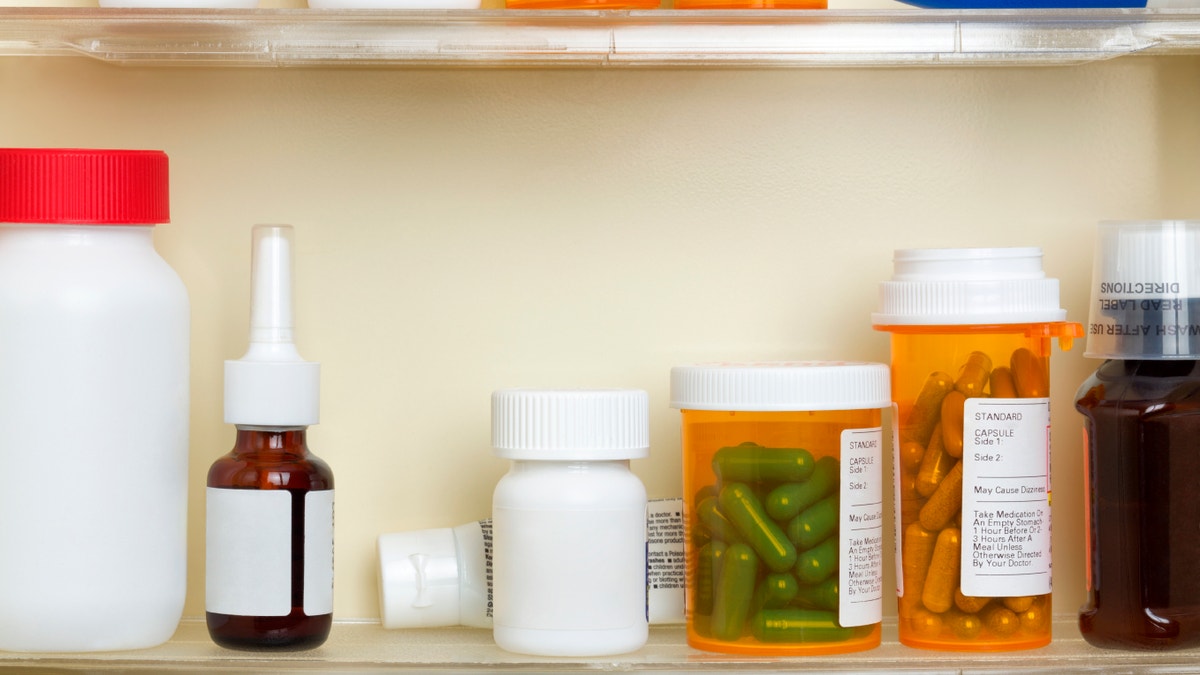
Several containers of over the counter and prescription medications on the shelves of a 1960's medicine cabinet. (iStock)
Throughout 2015, prescription drugs’ steep price increases were in the news over and over, and 2016 doesn’t look to be much different.
Already, Pfizer has raised the price of more than 60 of its branded drugs an average of 10.6 percent this month, according to The Wall Street Journal. Allergan, which is in negotiations to be acquired by Pfizer, raised prices an average of 9 percent this month, and other drug makers are following suit.
It’s not all bad news. For heart disease patients whose only option is Crestor, Zetia or Benicar, generics will likely be available soon to replace their pricey medications, according to prescription benefits manager Express Scripts. HIV patients taking Kaletra, Norvir or Epzicom may also have generics to look forward to this year. As these and 24 other drugs go off patent in 2016, generics manufacturers are likely to overtake the markets for them and save consumers money.
READ MORE: The Top-Selling Drugs in America
For many Americans who take daily prescriptions— 49 percent of all adults, according to the Centers for Disease Control and Prevention (CDC)— there is no such luck. However, there are still ways you can save on your drugs aside from manufacturers’ coupons and discount programs. Here are a few you may not have heard of.
1. Use alternative pharmacies
Because prescriptions are so expensive these days, shopping around can definitely save some money. Mail-order pharmacies save money by cutting out the bricks-and-mortar drugstore, and then pass some of those savings on to consumers. If you’re interested, check your insurance policy to see whether it covers mail-order pharmacies. If so, ask your doctor’s office which one it prefers and for help getting set up with it.
READ MORE: 8 Things You Should Know Before Using an Online Pharmacy
If that’s not an option, you can still shop around for the right pharmacy in town. A good website for this is GoodRx.com, where you can enter the name of your drug and ZIP code; the site will then display prices for that drug in your area. Most of the time, it provides a price with a GoodRx coupon, which you can print from the website once you select your pharmacy.
2. Consider clinical trials
Depending on your condition, you may be eligible to participate in a clinical trial and receive some free care and medication. Clinical trials are a bit risky because the drug you’re taking hasn’t yet been cleared by the Food and Drug Administration (FDA) as safe, but the reward can be high, because you may end up taking a more effective drug than the one you currently use.
To participate in a trial, you’ll have to sign a consent form, agree to specific visit dates, and be healthy enough based on laboratory results, among other qualifications. However, these exams and visits should be free to you, and the staff should be able to answer all your questions. To find out if there are any open clinical trials near you, check out clinicaltrials.gov and search for your city and condition.
READ MORE: The Most Commonly Prescribed Drugs in America
3. Ask your doctor about pill splitting
If you take a low dose of your medication, pill splitting may save you money. Since most drugs come in several doses, and 100 mg usually doesn’t cost twice as much as 50 mg, for example, purchasing double doses of your pills and cutting them in half can be a thrifty choice.
This tactic doesn’t work for every person or every pill, so it’s important to get your doctor’s approval before splitting. Extended release pills or hormone medications such as birth control should not be split, along with some others, but your doctor will know for sure. You’ll want to cut your pills perfectly in half to ensure proper dosing, so once your doctor writes the new prescription, pick up a pill splitter from your pharmacy for $5 to $10.
4. Take advantage of discount programs
If you take a particularly pricey drug, you might already be aware of the manufacturer’s discount or coupon program, since most pharmaceutical companies have some sort of savings system. However, these are usually available only to people with insurance at certain income levels and don’t always cover enough of the drug’s cost to make it affordable.
READ MORE: Cheap Prescriptions: How to Find the Most Bang for Your Buck
There are some independent discount programs that may do more to lower your costs. If your finances leave you below 500 percent of the federal poverty level, you may qualify for the Patient Access Network’s (PANfoundation.org) program for your condition, which provides money to pay for disease-related costs, including prescriptions.
For just drug discounts, independent discount cards are available at rxassist.org and familywize.org with no income restrictions. When you log on to these sites you’ll have to provide your personal information, but the discount cards are free.
As costs keep rising, it’s easy to get discouraged, but with a little extra work and time spent researching your options, you should be able to find ways to save on your prescription drugs.
